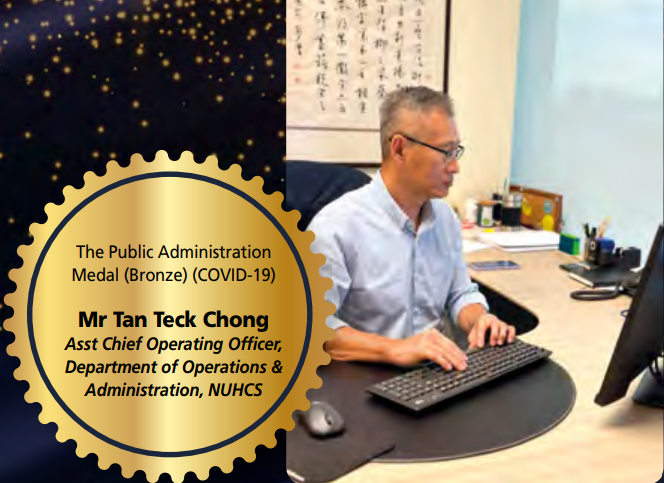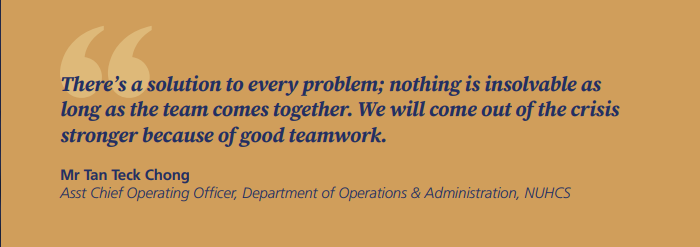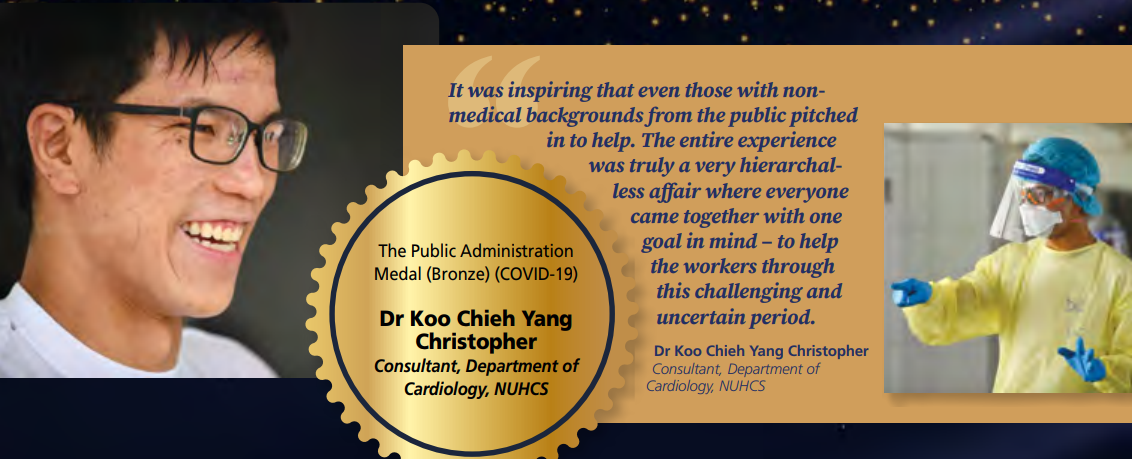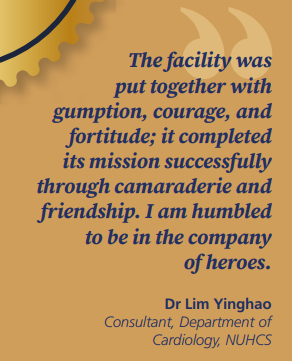Beyond The Call Of Duty: National Awards For COVID-19
For staff who have gone beyond the call of duty during the pandemic
PULSE Issue 41 | July 2023
In recognition of their public spirit and outstanding contributions to Singapore's fight against the COVID-19 pandemic, about 9,500 individuals from the public healthcare, public, private, and people sectors have been recognised and will receive the National Awards (COVID-19), announced at the 2022 National Day Rally. The number and spread of individuals receiving the awards reflect how the fight has been a nationwide effort.
These National Awards honour all those who have gone beyond their duty and contributed to the efforts in fighting againt COVID-19.
At NUHCS, three received The Public Administration Medal (Bronze) (COVID-19) shares more about how they went beyond their call of duty during the COVID-19 pandemic.
The Public Administration Medal (Bronze) (COVID-19)
The Public Administration Medal (Bronze) (COVID-19) is awarded to individuals who led and implemented efforts that contributed to the management of the impact of COVID-19 on Singapore. The award recognises the hard work and personal dedication of these individuals who had to respond quickly to the unpredictable pandemic situation, with no compromise in standard of professionalism and excellence.
The Commendation Medal (COVID-19)
The Commendation Medal (COVID-19) is for individuals who performed outstandingly in their role during the COVID-19 pandemic. These individuals displayed great courage and dedication beyond the call of duty while maintaining a high level of professionalism.
Mr Tan Teck Chong, Asst Chief Operating Officer (ACOO), NUHCS
 In April 2021, there was a surge in COVID-19 cases which had a huge impact on the National University Health System (NUHS), including National University Hospital (NUH). However, as a hospital, it was critical that operations continued to care for the sick.
In April 2021, there was a surge in COVID-19 cases which had a huge impact on the National University Health System (NUHS), including National University Hospital (NUH). However, as a hospital, it was critical that operations continued to care for the sick.
To mitigate the situation, Mr Tan Teck Chong, Asst Chief Operating Officer, NUHCS, was appointed as the leader of NUHS’s task force to organise swabbing operations for the entire staff population situated at the Kent Ridge campus. This includes about 10,000 staff, includ�ing students, cleaners, vendors and tenants who were working every day to keep the hospital running.
Mr Tan put together a team from scratch and set up a swabbing oper�ation facility for Rostered Routine Testing (RRT) via Oropharyngeal and Mid-Turbinate Swab (OPMT) – a type of swab where the sample is taken from the back of one’s throat and nostrils – for every staff situated in the Kent Ridge campus.
The entire exercise continued for about five months until the situation stabilised.
About 100,000 tests were conducted and processed in the laboratories. Further precautionary measures as well as protocols were communicated to every staff to minimise any risk of infection.
What was your motivation behind the role?
There was a real sense of urgency to get ahead and maintain control over the situation. As the regional healthcare system for the west, safeguarding the health of everyone working here was critical for us to continue serving the greater public. The last thing we wanted was an outbreak in the hospital, which was very possi�ble, and having to close the hospital to prevent further infections.
Could you share some of the challenges you faced?
We had to carve out some resources to allocate to this exercise. To avoid taxing our medical staff who were already busy with sick patients, we conducted crash courses for non-medical staff so that they could help out with voluntary duties such as swabbing. The uncertainty of how long the pandemic would last was worrying as I had to manage the sustainability of our resources including our manpower – there was a limit to how long we could keep up with all the extra shifts.
How has the experience impacted you?
What amazed me was that many colleagues willingly put up their hands to take turns in shifts to ease one another’s workload. Everyone showed tolerance, understanding, and support. Personally, I think we survived the pandemic because of the solidarity and support we have at NUHS.

Dr Koo Chieh Yang Christopher, Consultant, Department of Cardiology, NUHCS
Following an outbreak of COVID-19 in migrant worker dormitories, Singapore placed all dormitories under isolation from mid-April as part of the nation’s strategy to stem transmissions and protect the health of workers.
At the peak of the outbreak, more than 1,000 new cases a day were being detected among the workers. Cases surged from 31 in April 2020 to over 15,000 in May, and 33,000 in June. Dr Koo Chieh Yang Christopher, Consultant, Department of Cardiology, NUHCS, was approached to join the medical core group in charge of the COVID-19 medical operations at the largest dormitory in Singapore, which housed about 25,000 workers. His first task was to provide immediate daily medical care to the workers who had COVID-19 and were quarantined within the dormitory.

To contain and clear the dormitories of COVID-19, medical support was set up within the dormitories to care for and monitor the health of the workers, as well as to conduct regular testing. As the situation wore on, the medical team built rapport with the foreign workers to gain their trust during a time of fear and uncertainty. It took over four months before all the dormitories were cleared of the virus. Nine in 10 workers in the construction, maritime, and process sectors could return to their jobs.
What motivated you to take up this role?
It was not the first time I have worked with migrant workers. I always thought we could do more to appreciate their efforts. Hence, when the opportunity presented itself, I said yes. This meant I had to leave my work at NUHCS to be in the dormitories, but thankfully, my colleagues were willing to cover my clinical duties in the hospital.
Could you share some of the challenges you faced?
Having to adapt to a sudden change in the working environment took some adjustments. We donned the full Personal Protection Equipment (PPE) whilst working under the sun and were drenched in buckets of sweat every day. There was also a language barrier, so we had to come up with creative ways to get critical information across both ways. The most challenging though was managing the frustration and fear of the workers when we did not have all the answers back then. There were times when workers got hostile or were suicidal. We could only practice patience and be calm in such situations, so we could find ways to help.
How has the experience impacted you?
It was a very intense period, but I gained a lot of learning points from this experience. I got to see a different side of my colleagues, befriend those in other departments I would never have otherwise met. I made friends amongst the workers, who would message me about their fears, lives back at home, and offer to meet up after the pandemic. It is the relationships that I have built that I will remember the most.
Dr Lim Yinghao, Consultant, Department of Cardiology, NUHCS
As part of the nation's response to the pandemic, the National University Health Systems (NUHS) looked into setting up a 1,622-bed community care facility for COVID-19 patients to reserve hospital beds for those who were very sick.
Dr Lim Yinghao, Consultant, Department of Cardiology, NUHCS, volunteered to lead the project, taking on the responsibilities of planning and getting the facility ready to meet the fast increasing number of COVID-19 patients.
Without pre-determined guidelines, he not only had to direct his team in setting up a new medical facility but had to map out its operating protocols. The facility had to be adapted to recuperate sick patients with segregated zones to prevent the spread of disease infections, and be flexible enough to be quickly scale up or down depending on how the situation progressed in Singapore.

After the facility was set up, he remained as the medical co-lead to care for patients who were admitted to the facility. Together with his team, the Tuas Community Care Facility was set up in just three weeks, and run fully on-site by the medical and nursing team before it closed.
What motivated you to volunteer for this role?
The decision to volunteer was not an easy one. At that time, there was widespread fear that the virus could be fatal and it was already seen to be extremely infectious. But, I was lucky to have the full blessings and support of my wife as well as from my family and colleagues. Thus, I decided to take on the role. It was a time of need for our nation - that was impetus enough.
Could you share some of the challenges you faced?
The greatest challenge was navigating the sea of uncertainty in a rapidly developing global situation. No one knew what the virus was and what trajectory the disease would take. That made planning tricky. We had no way of knowing how long the situation would last, except to make the best preparations possible.
How has the experience impacted you?
I am and remain inspired by the passion and dedication of the entire team involved. These are people who selflessly stepped forward to serve when they were needed, and served without a complaint. Not surprisingly, they have since moved on to achieve excellence in each of their fields.
